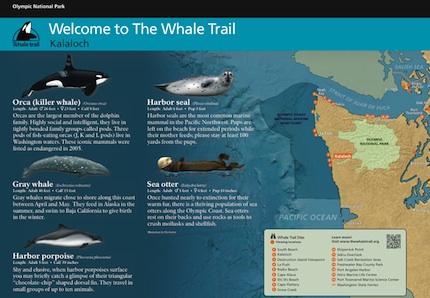Knowing where to look for whales, and how to identify the whales you see, is getting easier at Olympic National Park thanks to The Whale Trail, the Olympic Coast National Marine Sanctuary, and the park staff.
On April 11 a "Whale Trail" sign will be dedicated at Kalaloch Lodge on the Olympic Peninsula’s Pacific Ocean shore. On it you'll find information about gray whales, sea otters and endangered orcas that frequent the area.
The dedication will take place from 11 a.m. to 12:30 pm. The ceremony will feature a keynote address by Jefferson County Commissioner Phil Johnson, and representatives from Olympic Coast National Marine Sanctuary, Olympic National Park and The Whale Trail. The event is free and open to the public.
The program will also feature Hoh tribal storyteller Viola Riebe, director of cultural resources.
“Whale Trail signs are simple but powerful reminders that orcas and other marine mammals live in our waters,” said Donna Sandstrom, executive director of The Whale Trail. “The Kalaloch sign encourages visitors to look at this spectacular seascape with a deeper understanding of the diversity of life it supports, and our role in protecting it."
Twenty-nine species of marine mammals live in or pass through the waters of the sanctuary. At vantage points in Olympic National Park visitors might spot migratory gray whales, sea lions, harbor porpoise, harbor seals, sea otters and orcas.
"I was a commercial fisherman for 12 years," said Jefferson County Commissioner Phil Johnson. "I had the opportunity on many occasions to observe these amazing creatures up close and spotting a pod of whales was always the high point of a trip."
“No one walks away from an encounter with an orca or grey whale without being awestruck and hopefully eager to learn more,” said Carol Bernthal, superintendant of Olympic Coast National Marine Sanctuary. “The health of the ocean is challenged right now by big issues like climate change and ocean acidification and it will take the political will and actions at the local and international level to make the necessary changes in policy to better protect our ocean. It starts with awareness of the need to protect these places and animals.”
“We are happy to have provided the funding and staff support for producing signs at Kalaloch, Snow Creek, and Port Angeles in partnership with The Whale Trail and Olympic National Park,” said she said.
The Whale Trail sign at Kalaloch is the first sign placed within the Olympic National Park.
"We are pleased to host this stop on the Whale Trail and grateful for the strong partnerships that have made this possible," said Olympic National Park Superintendent Sarah Creachbaum.
The Whale Trail has also identified whale-viewing sites at La Push (Quileute Nation) and Cape Flattery (Makah Nation) and dozens of other sites on the Olympic Peninsula and in Puget Sound. Through its current signs alone, including two on every Washington State ferry, The Whale Trail reaches more than 22 million people each year.




Add comment